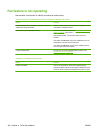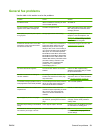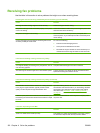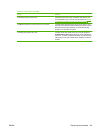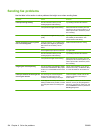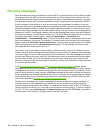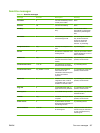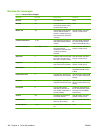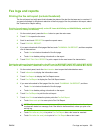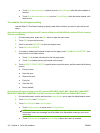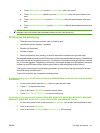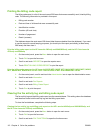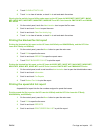
Fax error messages
When an analog fax is sent or received on a LaserJet MFP, any errors that occur during the fax process
will be displayed on the MFP control panel and entered into the fax reports. Fax errors can occur for
many reasons and often they are due to interruptions or noise on the telephone connection. Any error
that takes place during the fax process regardless of where it originates will be displayed by the MFP.
If the fax process is interrupted or an error occurs during a fax transmission or reception, a two part
status/error description is generated by the fax subsystem on the MFP. Normal or successful faxes also
generate messages indicating success. The message information consists of a text description and a
numeric code (a few messages don’t include numeric codes). Only the text part of the message will be
displayed on the MFP control panel; however, both the text message and numeric code will be listed in
the Fax Activity Report, Fax Call Report, and the Fax T.30 Trace (these fax reports can be printed out
individually from the MFP control panel – under the Administration > Information and
Administration > Troubleshooting menus). The numeric code is shown in parentheses after the text
part of the message in the reports. For example, if a communication error occurred, the control panel
display would show Fax Failed: Communication Error. The same error would be shown in the Result
field in the Fax Activity Report as Communication Error (17). For this example, the numeric code
associated with this communication error is ‘17’.
The numeric code is generated by the fax modem. Usually a numeric code of (0) indicates a normal
modem response. Some messages will always display a numeric code of (0), whereas other messages
can have a range of numeric codes depending on the circumstances, and a few messages will have no
numeric code. Usually a numeric code of (0) indicates an error was not associated with the fax modem,
but occurred in another part of the fax subsystem. Non-zero error codes give further detail into the
particular action or process that the modem is executing, and they don’t necessarily indicate that there
is a problem with the modem.
In the
Send-fax messages on page 107 and Receive-fax messages on page 108 tables, the fax
messages with the most common number codes are given with recommended corrective action. Several
messages that are normal or indicate a normal event are also included in tables. For example, if a fax
was not able to be sent to a busy number, a Fail Busy message will be shown. Nothing is wrong with
the fax subsystem; the message indicates the fax was not completed due to a busy telephone number
at the receiving end. Further troubleshooting information is available in the HP MFP Analog Fax 300
User Guide (available at
http://www.hp.com/go/mfpfaxaccessory300).
Persistent error messages with numeric codes different than those listed here require assistance of
customer support. A more detailed listing of the last fax call can be printed out before contacting
customer support to help identify the problem. The detailed fax listing is called a Fax T.30 Trace and
can be printed for the last fax, or it can be set to print whenever a fax error occurs. To print or configure
the Fax T.30 Trace, press Administration, Troubleshooting, and then Fax T.30 Trace. You can then
print the report for the last fax or configure when to print the T.30 trace.
106 Chapter 4 Solve fax problems ENWW





